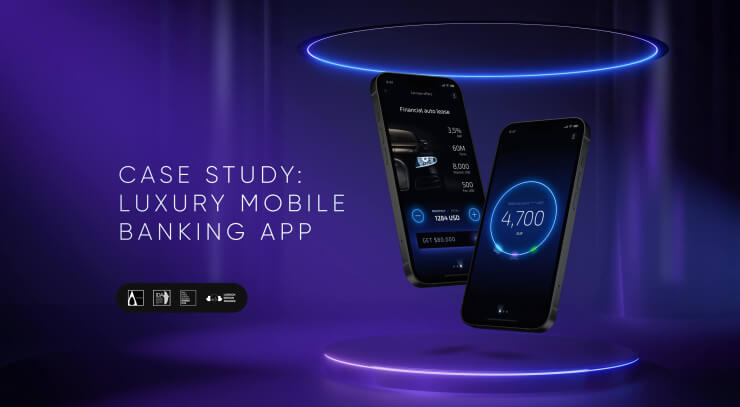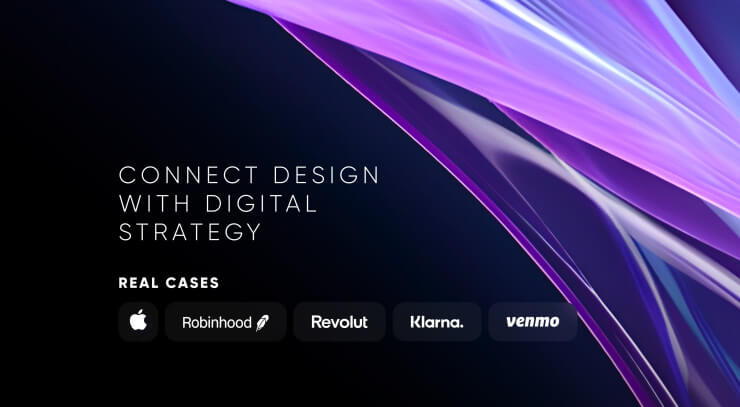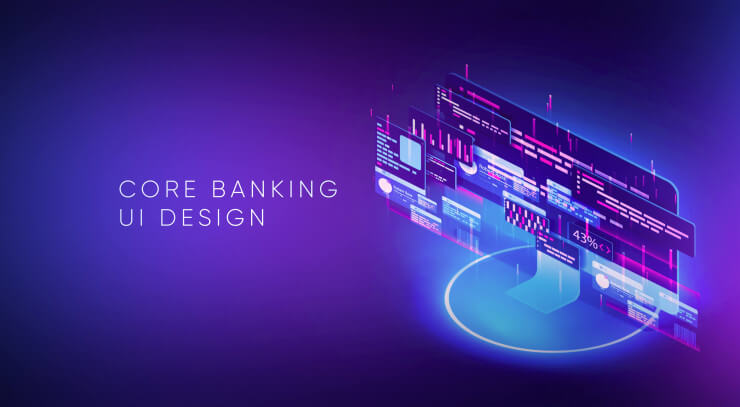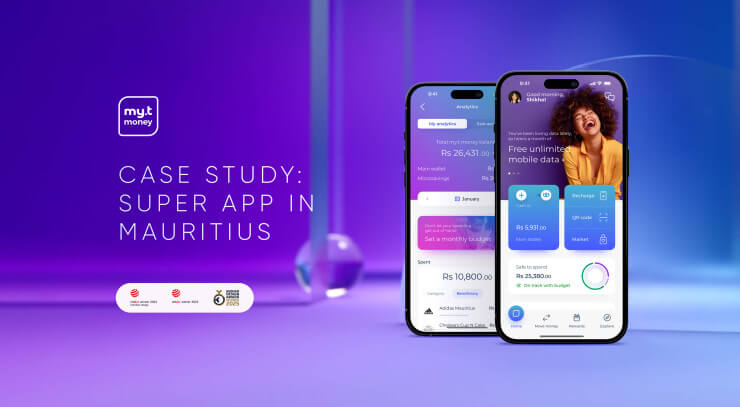In the era of rapid technological evolution, the battleground for supremacy in the financial sector has shifted to the digital realm. The traditional brick-and-mortar facade gives way to sleek digital interfaces. The importance of delivering an exceptional user experience (UX) has emerged as a paramount strategy for financial institutions (FIs) seeking to outshine the competition. And a UX audit significantly helps to detect friction and improve financial products.
Many digital banking platforms are in urgent need of updating. Banks know that changes are needed, and their customers are also demanding and waiting for this. However, not every financial institution can immediately invest the time and enormous resources required to achieve a digital transformation. So where do they start and what can they do to support the transformation along the way? A financial UX audit can be a good first step and the launch pad for your digital rocketship. It will give you insights into where you are, what your customers are waiting for and how to get there step by step.
McKinsey data shows that using technology to revamp the customer experience could increase customer satisfaction by 15-20%, reduce costs to serve by 20-40% and boost conversion rates and growth by 20%. But the desire to provide basic digital functionality could overshadow the deeper meaning of user experience. The result? Complex, unattractive interfaces that do not meet users' basic needs and concerns and have nothing to do with the brand identity. This misstep hinders user engagement and exposes financial institutions to fierce competition in an oversaturated digital landscape.
For example, one of our clients was very surprised when he heard complaints in a user interview that the banking app was missing a key feature. Even though it was there, users could not find it under the confusing title, and they simply had to put up with the inconvenience.
Crafting a great UX for financial products isn't just about appearances or features; it's about understanding, engagement and the seamless fusion of technology with customer needs. And a UX audit in banking helps to detect critical product touchpoints to improve your product’s UX.
Financial UX Audit Unlocks Insights at Your Fingertips
For retail banks in Europe and Asia Pacific, improving customer service is first on the list of investment priorities, according to PWC research, and it ranks second in the US after regulatory compliance. Therefore, huge resources are spent on digital transformation and customer-centric initiatives. And after years of hard work and the launch of a financial product, it may seem like the job is finally complete; however, this is far from accurate.
Feedback from our clients highlights a challenge. While certain project teams grapple with outcomes of the financial digital product that don't align with expectations, others (even though actively collecting input) are still determining how to proceed due to the diverse range of comments they're receiving. This added complexity magnifies the challenge of defining a starting point for product enhancement activities, particularly given the substantial time and effort invested in creating such a digital product.
According to PWC research in 2020, in the next five years, most banks (54%) plan to focus on improving the collection of customer data. The journey of ongoing improvement only commences post-product launch, when user interactions open avenues for gauging user behavior and product experiences.
There are multiple methods for gathering user feedback and tracking usage patterns. These include utilizing specific online tools like Google Analytics, HotJar and others to pinpoint user navigation, interactions with the product and the amount of time spent on different sections. Survey forms are also employed to gather user feedback and recommendations. Additionally, conducting user interviews and tests provides insights into how individuals utilize the product, their goals and the emotions they experience during its use.
Gathering this information is essential, but it can become overwhelming when there's a sudden influx of feedback, leaving you trying to figure out where to start. The most challenging aspect lies in effectively deciphering how to utilize the gathered information. It's not feasible to address or incorporate every request or concern voiced by users, nor should you do so. So the question arises: how do you prioritize efforts and construct an actionable plan for enhancing the product?
And the easiest and fastest way is a financial UX audit. We can name ten key benefits of a UX audit for financial digital products:
1. Feel the struggles from the user perspective
It allows FIs to pinpoint critical touchpoints in which customers interact with financial services. By systematically mapping user flows and journeys, FIs comprehensively understand the customer's perspective. This holistic approach extends beyond traditional data analysis, allowing FIs to uncover gaps in the user experience and recognize moments that truly matter to customers.
2. External UX experts opinion
Secondly, this approach promotes innovation by encouraging teams to view their products from a fresh customer-centered perspective by UX experts. By aligning data-driven analysis with a deep understanding of user behavior, a UX audit empowers FIs to identify growth points while fostering a customer-centric approach.
3. Suggestions based on best practices and a to-do plan
A customer-centric UX audit in banking bridges the data and human experience, transforming raw information into actionable insights. This approach is not about embarking on grand, resource-intensive research projects but about switching angles to detect the most impactful areas for improvement.
4. Problem identification
A UX audit for financial products helps spot usability issues, enhancing the product to meet user needs. For instance, UXDA’s UX audit for a leading middle eastern bank led to design improvement based on customer journey mapping and usability testing, resulting in Google Play Rate growth from 2.8 to 4.7.
5. User adoption improvement
Optimization of confusing user flows, such as the onboarding process as part of a banking UX audit, has the potential to bring phenomenal results. It enhances adoption and improves the user learning curve. Another deep analysis of UXDA’s clients’ platform resulted in acceleration of the user learning curve from several months to just a few hours.
6. Customer retention
Enhancing usability through a banking product UX audit improves customer retention. Negative experiences lead to potential churn, while positive experiences increase loyalty. According to Zendesk research, 81% of customers, following a positive customer service experience, will make another purchase, and 61%, after one negative experience, would switch to a competitor. Around 50% of customers who have had a bad mortgage experience will search for refinancing with another bank, according to McKinsey research.
7. Cost savings
Addressing usability issues in a timely manner through a financial UX research allows you to achieve significant business results with much lower costs. A well-executed audit will also help prioritize necessary improvements, ensuring that critical usability issues are found and solved first. In the long run, such prioritization saves time and costs, further improving the ROI of UX. which is estimated to be around 9,900%, according to a Forrester study.
8. Enhanced brand perception
Improved user experiences resulting from a financial UX audit can positively impact brand perception. A study by McKinsey found that a consistent brand experience can increase customer satisfaction by 20%, potentially leading to greater brand loyalty.
9. Competitive edge
Regular UX audits identify areas in which service should meet customer expectations, allowing it to move ahead of its competitors. That helps ensure consistent growth and market success and validates the need for technological solutions to be the first to innovate in the industry.
10. Data-driven growth
A UX audit for financial products provides data-backed insights, allowing informed design decisions and customer-centered improvements. Many FIs use the voting principle, in which users can send ideas for product improvements, and then the community votes, thus placing user feedback at the forefront of product development.
One of our client's product teams prioritized user scenarios and found that what they spent significant resources on turned out to be unimportant to users, and what they considered insignificant was their product's main advantage. This data was always there, but they did not see it.
5 Steps of a Financial UX Audit
The UX audit process shifts perspective in data analysis and detects key touchpoints for product improvement. It takes a month on average and consists of five main steps:
1. Researching business context
The journey begins by defining the FI's business context: brand identity, mission, strategy and value proposition. This foundational step ensures the financial product's UX audit aligns with the institution's core objectives.
2. Defining users and prioritizing scenarios
Identifying a clear user profile and prioritizing scenarios allows the team to align when considering how individuals interact with the product. Forming a cross-functional team that includes UX researchers, designers, developers and business stakeholders is crucial. This ensures that everyone shares a common understanding and perspective.
3. Mapping user flows and journey
Creating a comprehensive map of user flows and the customer journey helps pinpoint pain points and opportunities for enhancement. This step allows understanding of the user's interaction with the product, leading to more effective design changes. Collaborating with existing data teams, data analysts and support services helps inform research with valuable insights.
4. Evaluating flows and the user experience
According to research by Nielsen Norman Group, testing a user interface with only five participants is enough to find 85% of the usability problems.
Engaging with users offers a valuable opportunity to observe how they truly carry out specific tasks within the product and gather their impressions about the experience. This process helps in pinpointing pain points. Scrutinize every element visible to users on the screens, and you might come up with numerous solutions. Pay attention to the overall look and feel; does the product incorporate the brand identity?
Utilizing the Impact vs. Effort Matrix, you can assess the potential impact of proposed solutions on the user experience and the level of effort required for implementation. This approach enables identifying "quick wins" ─ changes that can significantly enhance the user experience and are relatively simple to address.
5. Data-driven enhancement
The culmination of a UX audit involves analyzing the collected data to detect key product touchpoints that require improvement. FIs can detect and enhance the critical user experience touchpoints without a complete overhaul by focusing on these touchpoints. It is also an excellent opportunity to assess and justify the need for complex changes and transition to a new technological platform.
Example: one bank's team was shocked when they explored key user flows from their product screens. It became obvious that users were frustrated with the excessive number of steps and overly complex process. With the help of minor design and code changes, it was possible to reduce the number of steps and smooth out the critical flow.
Within one month, external UX experts can help guide you through these steps, offering a fresh and unbiased viewpoint. They can provide valuable recommendations and insights on where next to direct their focus.
Embracing the Digital Disruption in Finance
In a digital age, in which competition is fierce and user expectations continue to soar, UX audit emerges as the compass guiding financial institutions toward innovation that truly matters. By committing to a holistic understanding of their users, FIs can craft financial products that resonate deeply with the needs and desires of their customers.
Product development cycles in financial organizations often revolve around internal considerations, neglecting the crucial aspect of user experience. Because if a bank's ecosystem of administrative, service, products, IT, legal, marketing, operations, management, risk and sales departments is siloed, it makes it difficult for organizations to coherently perceive and develop digital offerings from the customer's point of view.
According to Global Benchmark Study by Publicis Sapient, 70% of C-level executives believe their organizations are ahead of the competition when it comes to optimizing customer experiences and providing innovative solutions, but only 40% of their senior management agree with this.
Fragmentation could result in disconnected interfaces and convoluted processes, relegating the user experience and product design to a secondary activity of the marketing department. This divergence from customer-centered thinking often creates a gap between what FI offers and what users truly need. While customer expectations evolve unprecedentedly, a UX audit of financial products helps to overcome this gap. UX design is not just an option; it's a strategic imperative for FIs aiming to survive digital disruption.
Get UXDA Research-Based White Paper "How to Win the Hearts of Digital Customers":
 If you want to create next-gen financial products to receive an exceptional competitive advantage in the digital age, contact us! With the power of financial UX design, we can help you turn your business into a beloved financial brand with a strong emotional connection with your clients, resulting in success, demand, and long-term customer loyalty.
If you want to create next-gen financial products to receive an exceptional competitive advantage in the digital age, contact us! With the power of financial UX design, we can help you turn your business into a beloved financial brand with a strong emotional connection with your clients, resulting in success, demand, and long-term customer loyalty.
- E-mail us at info@theuxda.com
- Chat with us in Whatsapp
- Send a direct message to UXDA's CEO Alex Kreger on Linkedin






















